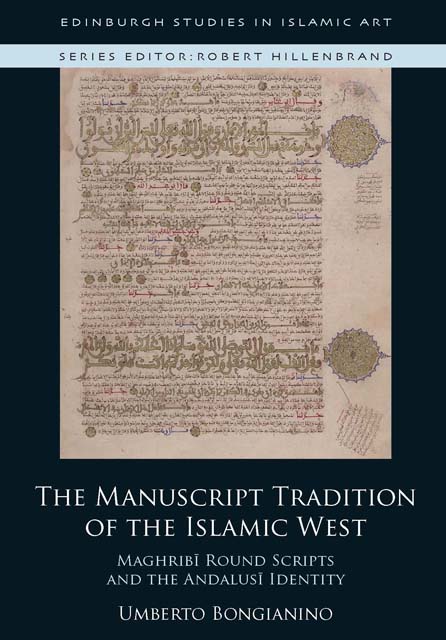Book contents
- Frontmatter
- Contents
- List of Figures
- Acknowledgements
- Note on Transliteration and Translation
- Abbreviations
- Series Editor’s Foreword
- Introduction: A Book about Books
- Chapter One Maghribī Round Scripts: A New Definition
- Chapter Two Maghribī Round Scripts in the Third/Ninth and Fourth/Tenth Centuries
- Chapter Three Maghribī Round Scripts in the Fifth/Eleventh Century
- Chapter Four Maghribī Round Scripts in the Sixth/Twelfth Century
- Chapter Five Beyond Books: Quranic Manuscripts and Chancery Documents
- Conclusion: Inscribed Identities
- I List of Dated Manuscripts
- II Titles and Genres of Dated Manuscripts
- III Copyists of Dated Manuscripts
- IV Places of Copying
- V Remarkable Colophons and Notes
- Glossary
- Bibliography
- Index
Chapter One - Maghribī Round Scripts: A New Definition
Published online by Cambridge University Press: 18 November 2022
- Frontmatter
- Contents
- List of Figures
- Acknowledgements
- Note on Transliteration and Translation
- Abbreviations
- Series Editor’s Foreword
- Introduction: A Book about Books
- Chapter One Maghribī Round Scripts: A New Definition
- Chapter Two Maghribī Round Scripts in the Third/Ninth and Fourth/Tenth Centuries
- Chapter Three Maghribī Round Scripts in the Fifth/Eleventh Century
- Chapter Four Maghribī Round Scripts in the Sixth/Twelfth Century
- Chapter Five Beyond Books: Quranic Manuscripts and Chancery Documents
- Conclusion: Inscribed Identities
- I List of Dated Manuscripts
- II Titles and Genres of Dated Manuscripts
- III Copyists of Dated Manuscripts
- IV Places of Copying
- V Remarkable Colophons and Notes
- Glossary
- Bibliography
- Index
Summary
Geography and chronology
AMONG THE FEW key tenets of the still emergent field of Arabic palaeography lies the distinction between western (or Maghribī) scripts and eastern (or Mashriqī) scripts. This dichotomy between writing styles and practices at the two poles of the Islamic Mediterranean – the Maghrib and the Mashriq – is historically rooted in the traditional division of the Arab world into two main macro-regions, differing from one another in numerous respects: religious doctrine and practices, ethnic composition, vernacular languages and, of course, visual and material culture.
As far as scripts are concerned, the distinction between Maghribī and Mashriqī is attested in Arabic literary sources from an early date. The medieval treatise Shawq al-mustahām fī ma ʿrifat rumūz al-aqlūm (‘Yearning of the Besotted in the Knowledge of Written Symbols’), a work on cryptic alphabets and their talismanic properties, begins by introducing the reader to three basic alphabets known as ‘Kūfī’, ‘Maghribī’ and ‘Hindī’. The first is described as the primeval Arabic script; the second is the Arabic alphabet employed in the Muslim West, and more specifically in al-Andalus (‘al-qalam al-Maghribī wa-huwa al-Andalusī’); the third is the abjad or alpha-numeric system, where each Arabic letter corresponds to an Indian numeral. The earliest surviving manuscript of this work was copied in 1165/1751 from an exemplar dated 413/1022 that, in turn, reproduced an autograph allegedly from the year 241/856. Despite the alterations that may have occurred during the two subsequent transcriptions, the chart presenting each Maghribī letter captioned by its Mashriqī equivalent (Figure 1.1) is a precious indicator of the differences arisen between the two writing systems already in the Abbasid period.
The distinct aspect and special nature of Maghribī scripts was well known to medieval Arabic authors in the Mashriq, who occasionally even showed a certain appreciation for them. The Ayyubid historian and administrator Jamāl al-Dīn al-Qifṭī (568/1172–646/1248), for instance, in his biographical dictionary and anthology of poets named Muhammad, includes the Malagan Muhammad Ibn al-Fakhkhār (d. 539/1145) and describes him as having ‘a beautiful handwriting, of the kind used by the people of al-Andalus [la-hu khatt hasan min khutū t ahl al-Andalus]’. Al-Qifṭī claims to have personally seen a book copied by Ibn al-Fakhkhār and confirms that his calligraphy was indeed ‘exceedingly handsome and precise’.
- Type
- Chapter
- Information
- The Manuscript Tradition of the Islamic WestMaghribi Round Scripts and Andalusi Identity, pp. 13 - 71Publisher: Edinburgh University PressPrint publication year: 2022

